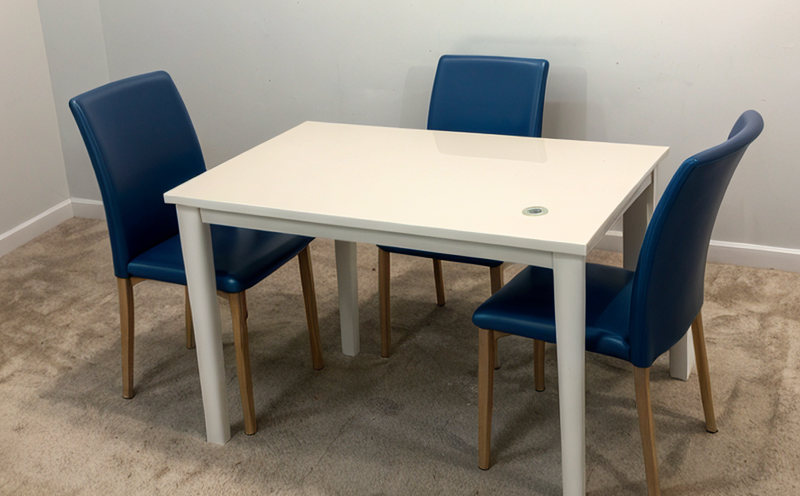DIN EN ISO 527 Tensile Properties Testing of Interior Plastics
The DIN EN ISO 527 tensile properties testing method is a standard procedure used to determine the tensile strength and other mechanical properties of plastics. This particular test focuses on interior plastic materials, which are commonly found in furniture, automotive interiors, and household goods where durability and safety are paramount.
For quality managers and R&D engineers working with interior plastics, understanding these mechanical properties is essential for product design and development. The tensile strength of a material provides insight into its resistance to breakage under tension, which is critical in ensuring the long-term stability and integrity of products like seat covers, armrests, and door panels.
The testing process involves preparing specimens according to specified dimensions and tolerances defined by DIN EN ISO 527. Specimens are then subjected to a controlled stress until failure occurs. The maximum load at which the specimen fails provides the tensile strength value. Additionally, elongation at break is measured as an indicator of ductility.
The use of this standard ensures consistency and comparability across different laboratories worldwide. Compliance with DIN EN ISO 527 also facilitates market entry into European Union countries where these standards are recognized and required by regulatory bodies.
For procurement professionals, understanding the tensile properties of interior plastics helps in selecting suppliers who adhere to high-quality manufacturing practices and meet stringent testing requirements. This ensures that purchased materials not only perform well but also comply with international norms and regulations.
In summary, DIN EN ISO 527 tensile properties testing plays a crucial role in the quality assurance process for interior plastics. It provides critical data needed by various stakeholders involved in product development and manufacturing processes.
Benefits
The implementation of DIN EN ISO 527 tensile properties testing offers numerous advantages to furniture manufacturers, designers, and suppliers:
- Improved Product Quality: By adhering to this standard, companies can ensure consistent product quality across different batches and production runs.
- Enhanced Safety: Ensuring that interior plastics meet the specified tensile strength requirements helps prevent accidents caused by material failure.
- Cost Efficiency: Early detection of substandard materials through rigorous testing reduces rework costs and improves overall efficiency in the supply chain.
- Market Access: Compliance with international standards opens doors to global markets, particularly within the EU where these specifications are widely recognized.
These benefits collectively contribute to building a more reliable and safer interior plastics industry.
Environmental and Sustainability Contributions
The testing of tensile properties in interior plastics contributes positively towards environmental sustainability by promoting the use of high-quality, durable materials. The ability to accurately measure tensile strength allows manufacturers to select eco-friendly alternatives that offer comparable performance without compromising safety or comfort.
Incorporating sustainable practices into product development also helps reduce waste generation and promote recycling initiatives. By ensuring that interior plastics meet strict mechanical property standards, manufacturers encourage the use of recycled content while maintaining structural integrity.
Moreover, the testing process itself can be adapted to minimize environmental impact by optimizing specimen preparation methods and reducing energy consumption during testing procedures. These efforts align with broader sustainability goals aimed at reducing carbon footprints throughout the product lifecycle.
Use Cases and Application Examples
| Use Case | Description |
|---|---|
| Furniture Design Optimization: | Determining the tensile strength of different plastic materials allows furniture designers to select optimal materials that balance cost, weight, and functionality. |
| Material Supplier Evaluation: | Tensile tests conducted by suppliers can be compared against DIN EN ISO 527 standards to assess material quality before final selection. |
| Product Safety Assurance: | The results of tensile strength tests are used to ensure that interior plastics meet safety regulations, protecting consumers from potential hazards like breakage or splintering. |
| Recycling Process Improvement: | Tensile data helps in optimizing the recycling process by identifying which materials can be effectively reused without compromising their mechanical properties. |
| New Material Development: | DIN EN ISO 527 testing is essential for R&D teams working on new interior plastics formulations to ensure they meet performance requirements from the outset. |
| Supply Chain Transparency: | Tensile tests provide a transparent means of verifying material quality throughout the supply chain, enhancing trust between manufacturers and suppliers. |
| Regulatory Compliance: | Ensuring that interior plastics meet DIN EN ISO 527 requirements guarantees compliance with international standards, facilitating easier market entry for companies operating globally. |
The above use cases demonstrate the versatility and importance of tensile properties testing in various stages of product development and manufacturing processes within the furniture sector.





